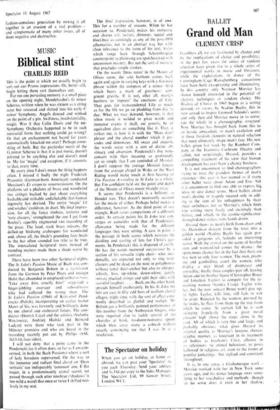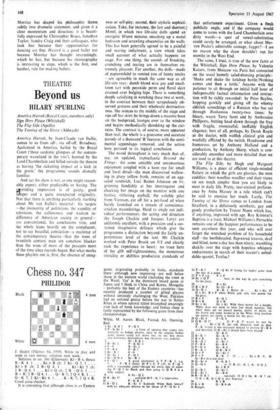Grand old Man
BALLET CLEMENT CRISP
Gamblers all, we are fascinated by chance and by she implications of choice and possibility; in the past few years the antics of random selection have given rise to a whole series of experimental works in music and literature, while the explorations in dance of the • unningham /Cage,' Rauschenberg consortium have been both exasperating and illuminating. In this country only Norman Morrice has shown himself interested in the potential of aleatory techniques or random choice. His Rea/ins of C'hoice in 1965 began as a setting devised, ex vacno. by Nadine Baylis; this in turn served to inspire I.eonard Salzedo's score; and only then did Morrice move in to corre- late the whole in a choreographic structure Now Morrice has thought back from this to an heroic antecedent, to man's evolution and to those freakish elements in natural selection that must ultimately shape man's fate. His new ballet, given last week by the Rambert Com- pany at the Jeannetta Cochrane Theatre and called, not surprisingly, Hazard, provides a compelling statement of his view that human development has ever been a chancy business.
It is not uncommon to find choreographers trying to treat the grandest themes of man's existence—this year it has seemed as if every other ballet were about Adam and Eve--but it is uncommon to find one able to express his, ideas in sure dance terms. Most ballets about man's destiny or tragedy succeed only in add- ing to the sum of his unhappiness by their sheer awfulness; not so Morrice's, which finds him writing more freely and excitingly than before, and which, in the cosmic-significance- through-dance stakes, wins hands down.
Hazard shows us man's birth from chaos and, his Darwinian descent from the trees into a golden world (Nadine Baylis has again pro- vided a gorgeous set, Salzedo an interesting score). With the arrival on the scene of brother men and womankind comes the drama: the eponymous chance lies in the fact that there are live men to only four women. The men, preen- ing and gambolling, court the women, who display a nice blend of disinterest and sensuality; finally three couples pair off, leaving Adam and his brother figure (Christopher Bruce :Ind Jonathan Taylor) to compete for the re- maining woman (Sandra Craig). Taylor wins her, but the now outcast Bruce won't give up; he tights Taylor,. kills him, still fails to win the prize. Rejected by the woman, pursued by the males, he flees from them up the tree from which he came. At curtain fall he is seen swinging- hopelessly from a great metal crescent high above the stage, alone in the said. All of which is very tine and large, and probably obvious; what gives Hazard its original quality is Morrice's luscious choreo- graphic manner, as luxuriant in its treatment of bodies as Graham's Circe, allusive in its references- -to animal behaviour, to poses hallowed in religious art, even to the forms of popular junketings —but stylised and consistent throughout.
It is, in one sense, a Grahamesque work- - Morrice worked with her in New York some sears ago, and his dance language owes some- thing to her vocabulary and methods—though in no sense does it exist in her shadow; Morrice has shaped his philosophic theme subtly into dramatic statement, and given it a clear momentum and direction; it is beauti- fully expressed by Christopher Bruce, Jonathan Taylor, Sandra Craig and their colleagues, who look fine because their opportunities for dancing are fine. Hazard is a good ballet not because Morrice has thought interestingly, which he has, but because his choreography is interesting as steps, which is the first, and hardest, rule for making ballets.































 Previous page
Previous page